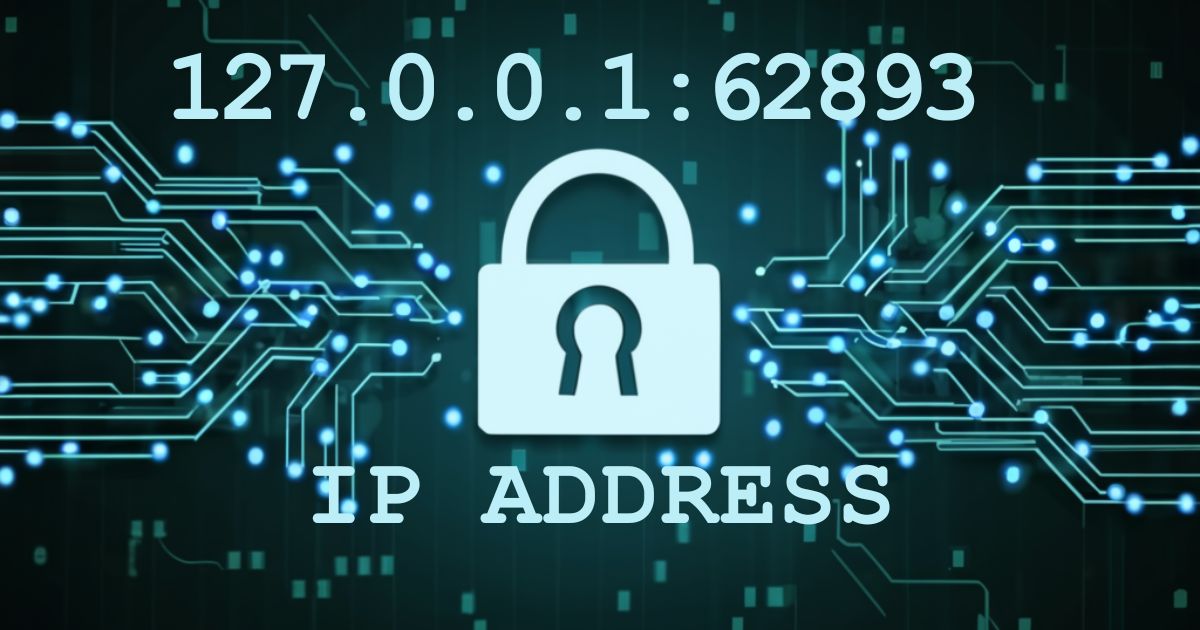127.0.0.1:62893: A Comprehensive Guide to Understanding, Benefits, and Troubleshooting
The term “127.0.0.1:62893” may seem cryptic at first glance, but for anyone involved in network management, software development, or IT support, it’s a common concept. This combination of an IP address and port number is essential to the way local networking works on any computer. Understanding how it operates, its benefits, and how to troubleshoot it can make a significant difference in maintaining optimal performance for web servers, applications, and network systems.
In this comprehensive guide, we will dive into the technical aspects of 127.0.0.1:62893, explaining how it works, its benefits, and common issues that arise when working with this IP-port combination. We will also provide optimized headings and content for improved search engine results and answer frequently asked questions.

Also Read: Reaching Within Shader: Unlocking Its Potential and Meaning
What is 127.0.0.1:62893?
To break it down, 127.0.0.1 is the IP address assigned to the localhost, and 62893 is a port number. Together, they represent a way for networked applications running on your computer to communicate with each other.
- 127.0.0.1: This is a loopback address, which means it is reserved for internal testing on a machine. Whenever a device tries to connect to 127.0.0.1, it is essentially communicating with itself.
- 62893: This is a port number, a gateway through which specific types of network traffic are directed. In most cases, when developers or system admins use this port, they are setting up or testing specific network applications locally before deploying them to the internet.
The combination of 127.0.0.1:62893 is often seen during software testing, web development, and other internal processes that need to avoid actual internet traffic.
Also Read: Reaching Within Shader: Unlocking Its Potential and Meaning
How Does 127.0.0.1:62893 Work?
Understanding how 127.0.0.1:62893 works requires breaking down its two components:
1. The Role of 127.0.0.1 (The Loopback Address)
The 127.0.0.1 loopback address is crucial in networking, especially for software development and testing. It allows a system to connect to itself without needing to go over the external internet. This is particularly useful when developers are building web applications or any service that requires communication over IP.
The IP address 127.0.0.1 routes traffic back to the machine from which it originated, allowing software to communicate with other services on the same device, mimicking network interactions.
- Self-Testing: By using 127.0.0.1, developers can test server-client communications on their own device without affecting any real-world networks.
- Local Network Applications: Various applications use 127.0.0.1 to operate local services. For instance, a web server like Apache or Nginx may use it to allow users to test websites on their own machine before they go live.
2. The Importance of Port 62893
A port is a gateway for transmitting data between systems. Each port number is like a channel for a specific type of communication, allowing different services or applications to run simultaneously without interference. In the context of 127.0.0.1:62893, port 62893 is used for internal communication or testing purposes.
Developers and network engineers assign specific port numbers, such as 62893, to separate tasks or processes. When combined with 127.0.0.1, this port enables local applications to simulate full network functionality by directing traffic to themselves via a specific, isolated channel.
Common Applications of 127.0.0.1:62893
The combination of 127.0.0.1:62893 is most commonly used in the context of software development, testing, and troubleshooting. Below are some common scenarios in which this IP-port combination comes into play:
1. Web Development
When building web applications, developers often run a local server on their machine, accessed via 127.0.0.1. The server listens for requests on a specific port, such as 62893, and allows the developer to test their website or application before deploying it to a live environment.
For instance, if you are developing a website using frameworks like Django or Flask (Python-based web frameworks), you might configure them to listen on 127.0.0.1:62893. This allows you to preview your changes, debug errors, and test new features without exposing your work to the public internet.
2. API Testing
When building or interacting with APIs (Application Programming Interfaces), you can use 127.0.0.1:62893 to test requests and responses locally. By simulating the communication between servers, you can test the robustness, speed, and error-handling capabilities of the API under development.
3. Local Database Management
For developers working with databases such as MySQL or PostgreSQL, setting up a local instance and accessing it via 127.0.0.1 and a port like 62893 allows you to perform queries and test database interactions without touching live data.

4. VPN and Proxy Services
Some VPN (Virtual Private Network) and proxy services use 127.0.0.1 addresses with specific ports (like 62893) to handle internal routing. This allows users to tunnel traffic locally while providing encryption or anonymity services.
Also Read: Reaching Within Shader: Unlocking Its Potential and Meaning
The Benefits of Using 127.0.0.1:62893
There are numerous advantages to using the 127.0.0.1:62893 combination, especially when it comes to local development, testing, and security. Below are some of the top benefits:
1. Safe and Isolated Testing Environment
By using 127.0.0.1, developers can test their applications in a safe, isolated environment. No external connections are involved, which minimizes the risk of outside interference or data breaches. You can effectively troubleshoot issues without worrying about exposing unfinished or unprotected systems to the internet.
2. Performance Testing
You can use 127.0.0.1:62893 to measure how efficiently an application runs on local resources. This type of performance testing can help ensure your app is resource-efficient before deploying it to a live server with actual network traffic.
3. Reduced Latency
When an application communicates over 127.0.0.1, it doesn’t have to travel over the internet, meaning there is virtually no latency. This makes the loopback address ideal for real-time testing where speed is crucial.
4. Debugging Made Easy
Debugging errors and troubleshooting networking issues are significantly easier with 127.0.0.1:62893. By simulating a network environment on your local machine, you can identify issues in your code or configuration before it affects your live setup.
5. Cross-Application Testing
Sometimes, multiple applications running on the same machine need to communicate with each other. By using 127.0.0.1 and unique port numbers like 62893, developers can allow these programs to interact seamlessly without needing an external network.
Also Read: Reaching Within Shader: Unlocking Its Potential and Meaning
Top Troubleshooting Tips for 127.0.0.1:62893
While using 127.0.0.1:62893 is generally straightforward, certain issues can arise. Below are some common problems and tips for resolving them:
1. Port Already in Use
Sometimes when you try to use port 62893, you may get an error stating that the port is already in use. This happens when another application or process has already claimed that port. To resolve this:
- Check which application is using the port by using terminal commands such as
netstatorlsof(on Linux/Mac) ornetstat -ano(on Windows). - If you find an unnecessary process occupying the port, terminate it or configure your application to use a different port.
2. Firewall Blocking the Port
Your system’s firewall might block traffic to and from port 62893. In this case, you’ll need to create an exception for the port in your firewall settings:
- For Windows, you can use the Windows Defender Firewall to create inbound and outbound rules for specific ports.
- On Linux-based systems, iptables or ufw can be used to open the necessary ports.
3. Application-Specific Configuration Errors
Sometimes, configuration files for applications like web servers or databases might contain errors that prevent them from listening to the specified 127.0.0.1:62893. Double-check your application’s configuration settings to ensure that the correct IP address and port number are specified.
4. Loopback Interface Issues
If your loopback interface (127.0.0.1) isn’t working, this could be due to misconfigurations at the system level. Make sure your networking stack is functioning correctly, and if needed, reset or restart your network interface.

Security Concerns Around 127.0.0.1:62893
Even though 127.0.0.1 is inherently more secure than using public IP addresses, there are still security concerns to be mindful of when using 127.0.0.1:62893:
1. Unauthorized Access
While the loopback interface should only be accessible from the local machine, certain vulnerabilities in operating systems or misconfigurations could expose services running on 127.0.0.1 to external threats. Make sure your firewall is configured correctly and that sensitive data is encrypted.
2. Open Ports
Having unnecessary open ports like 62893 can increase the attack surface of your machine. If 62893 is no longer in use, it’s best practice to close the port and disable the services associated with it.
FAQs About 127.0.0.1:62893
Q1: What is the purpose of 127.0.0.1:62893?
A1: 127.0.0.1 is the loopback IP address used by your device to communicate with itself, and 62893 is a port number that directs specific network traffic. Together, they allow local applications to interact as though they are on a network without involving external internet traffic.
Q2: How do I fix a port conflict with 127.0.0.1:62893?
A2: If port 62893 is already in use, you can identify the conflicting process using tools like netstat or lsof, and either terminate it or configure your application to use a different port.
Q3: Can external users access 127.0.0.1:62893?
A3: No, 127.0.0.1 is a loopback address that is only accessible from the local machine. It is not reachable from external networks, making it ideal for local development and testing.
Q4: Why is 127.0.0.1:62893 used in web development?
A4: Web developers use 127.0.0.1:62893 to test applications locally, ensuring that web services are functional before deploying them to a live server. This combination allows them to simulate a real network environment without external risks.
Conclusion
127.0.0.1:62893 is an essential tool in the realm of software development, testing, and local networking. By leveraging this loopback address and specific port, developers can create isolated environments that mimic network behavior, test applications, and troubleshoot issues without impacting live systems.
From web development to API testing and database management, 127.0.0.1:62893 provides a secure, efficient, and reliable method for handling internal network communications. By understanding its function, benefits, and troubleshooting techniques, you can optimize your local network setup and ensure that your applications run smoothly before going live.
Whether you are a seasoned developer or just starting, mastering the ins and outs of 127.0.0.1:62893 will significantly enhance your development and debugging process.
Also Read: Reaching Within Shader: Unlocking Its Potential and Meaning






